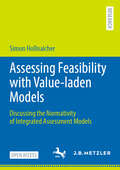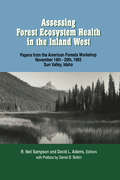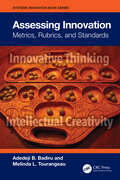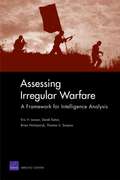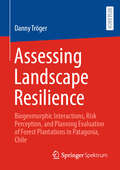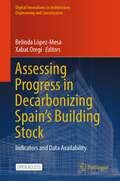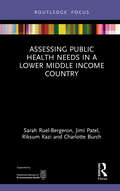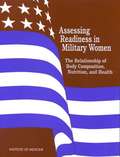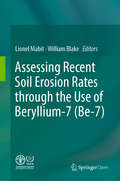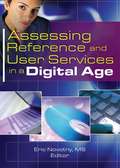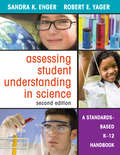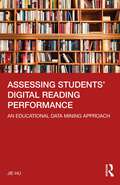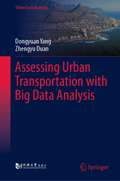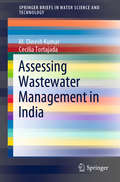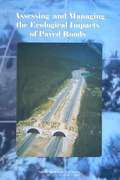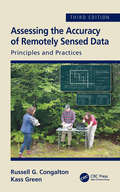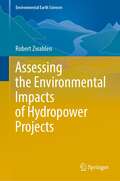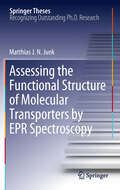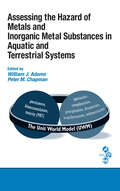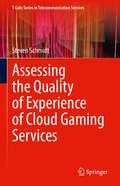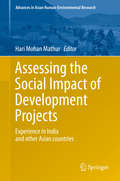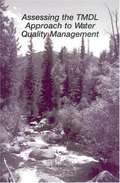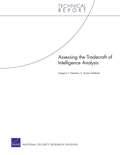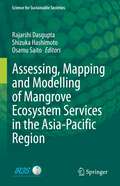- Table View
- List View
Assessing Feasibility with Value-laden Models: Discussing the Normativity of Integrated Assessment Models
by Simon HollnaicherIn this Open-Access-book, the author investigates the value dimension of Integrated Assessment Models and their application to questions of feasibility. Integrated models provide a quantified representation of the interaction between the socio-economic system with the climate and serve as a pivotal tool at the intersection of climate science, policymakers, and society. This book critically examines how IAMs approach the concept of feasibility. It unpacks the value assumptions embedded within integrated modeling, critiques the implicit normativity of these models, and proposes principles for responsibly managing value judgments in scientific advice. Arguing for a thick conception of feasibility—one that integrates key normative dimensions—it highlights the gap between conceptual discussions of feasibility and the scientific practices that inform feasibility assessments. Addressed to both philosophers and integrated modelers, this book sheds light on the implicit values shaping our collective visions for the future.
Assessing Forest Ecosystem Health in the Inland West
by David L. AdamsInland West, their historical origins, assessments of available management tools, and analyses of the various choices available to policymakers. Its goal is to help people understand the Inland West forests so that public policies can reflect a constructive and realistic framework in which forests can be managed for sustained health. This resource is the product of a scientific workshop where 35 participants, including scientists, resource managers, administrators, and environmentalists, addressed the forest health problem in the Inland West. Synthesis chapters integrate the diverse knowledge and experience which participants brought to the workshop. They identify and link together many of the ecological, social, and administrative conditions which have created the forest health problem in the West. The book is unique in that it reflects a process that fostered the use of academic research, field realities, and industrial knowledge to define an interdisciplinary problem, establish rational policy objectives, and set-up “do-able” management approaches.The following topics are analyzed: Assessing forest ecosystem health in the Inland West Historical and anticipated changes in forest ecosystems in the Inland West Defining and measuring forest health Historical range of variability as a tool for evaluating ecosystem change Administrative barriers to implementing forest health problems Economic and social dimensions of the forest health problem Fire management Ecosystem and landscape management
Assessing Innovation: Metrics, Rubrics, and Standards (Systems Innovation Book Series)
by Adedeji B. Badiru Melinda TourangeauWe cannot manage and control what we cannot measure and assess. Poor assessment results have been cited as a primary reason for project failures, in terms of cost, schedule, and quality. This book introduces metrics, rubrics, and standards pertinent to assessing innovation.Assessing Innovation: Metrics, Rubrics, and Standards provides a new view for the embracing of innovation and establishing a quantitative basis for determining innovation levels. It bridges innovation with practice and presents a systems view as it incorporates the human element and discusses the different roles carried out. This book offers standards that will guide readers as they tackle sustaining innovation and leverages Badiru’s Umbrella Model in the process.The inclusion of methodologies suitable for determining where and when innovation is happening, and to what extent it is currently being carried out, make this a unique book, along with being the only book that addresses innovation metrics, rubrics, and standards in an integrated fashion. Seen as a way to help advance the diverse pursuit of innovation, this book is an ideal read for those in engineering, business, industry, academia, government, and the military.
Assessing Irregular Warfare
by Eric V. Larson Brian Nichiporuk Derek Eaton Thomas S. SzaynaProvides an analytic framework and procedure for the intelligence analysis of irregular warfare (IW) environments that can serve as the basis for IW intelligence curriculum development efforts. Defines IW in terms of two stylized situations: population-centric (such as counterinsurgency) and counterterrorism. Provides a detailed review of IW-relevant defense policy and strategy documents and a list of relevant doctrinal publications.
Assessing Landscape Resilience: Biogeomorphic Interactions, Risk Perception, and Planning Evaluation of Forest Plantations in Patagonia, Chile
by Danny TrögerThis book examines the extent to which exotic pine plantations are a suitable strategy for maintaining the essential functions, structures, processes and identity of the Patagonian landscape over time. To this end, it integrates three empirical studies with inter- and transdisciplinary approaches under the theoretical framework of landscape resilience. The first study analyses the biogeomorphic interactions of different land uses and their relevance for soil conservation and landslide mitigation. The second study examines perceptions of natural hazards and focuses on networks of human and non-human actors that maintain landscape resilience. The results of these two studies are incorporated into the planning evaluation of land zoning and alternative strategies are developed, inspired by normative polycentric governance. It is concluded that Pinus plantations partially fulfil their ecological objectives of erosion control and landslide mitigation. However, their performance lags behind that of secondary forests with native species and they create new risks such as reduced biodiversity, increased risk of wildfires and conflicts with local identity. The book concludes with new research questions of trans-regional importance.
Assessing Progress in Decarbonizing Spain’s Building Stock: Indicators and Data Availability (Digital Innovations in Architecture, Engineering and Construction)
by Belinda López-Mesa Xabat OregiThis open access book delves into the topic of monitoring the effectiveness of building renovation policies within the European Union (EU) using indicators. Given the substantial environmental impact of existing buildings on energy consumption and greenhouse gas emissions, decarbonizing them is imperative for achieving climate neutrality in Europe. The use of indicators for monitoring decarbonization progress and evaluating policies emerges as a valuable tool, ensuring the efficiency, effectiveness, and alignment of building renovation policies with broader sustainability and climate objectives. Additionally, this approach facilitates evidence-based decision-making, promotes accountability by Member States (MSs), supports the realization of long-term goals, and actively involves the public in these vital initiatives. The European Commission is actively engaged in this realm, releasing a framework of optional indicators in 2019 and subsequently refining it during the review of the Energy Performance of Buildings Directive. The evolving framework seeks to encompass both mandatory and optional indicators, posing greater challenges for EU MSs in monitoring the impact of their national building renovation policies and the progress of decarbonizing their building stocks. This book offers insights into these developing indicator frameworks, assesses the availability and quality of data in the case of Spain, and suggests areas of improvement and innovative approaches using emerging technologies to enhance data. The target audience includes diverse stakeholders such as central government administrations, regional and municipal authorities, data-collecting institutions, urban planners, researchers, and citizens interested in comprehending the impact of building renovation. By addressing this broad audience, the book aims to foster a more inclusive and well-informed discussion on building renovation and the decarbonization of the European building stock.
Assessing Public Health Needs in a Lower Middle Income Country (Routledge Focus on Environmental Health)
by Sarah Ruel-Bergeron Jimi Patel Riksum Kazi Charlotte BurchThis book demonstrates a methodology for assessing public health needs in communities experiencing environmental sanitation inadequacies. Centring on a case study of the Republic of Cameroon, the findings represent the starting point of a campaign to implement a comprehensive water and sanitation infrastructure through advocacy, housing improvements, and new service chains. Based on an assessment report undertaken by ARCHIVE Global, an international non-profit organization focusing on the link between health and housing, this book: Explores and establishes a causal relationship between the built environment and its impacts on public health Uses the United Nations’ Sustainable Development Goals as a benchmark for highlighting issues and challenges with sanitation infrastructure projects Provides lessons for communities around the world facing environmental health issues similar to those Cameroon’s Idenau Municipality deals with. This book is intended for environmental health professionals, academics and policymakers, be they domestic to the African region or multinational practitioners. Donor countries, the likes of the United States and European nations, will also value the book’s advocacy for interventions in the built environment and current public health impacts.
Assessing Readiness in Military Women: The Relationship of Body Composition, Nutrition, and Health
by Committee on Body Composition Nutrition Health of Military WomenU.S. military personnel are required to adhere to standards of body composition, fitness, and appearance to achieve and maintain readiness--that is, the maintenance of optimum health and performance so they are ready for deployment at any moment. In 1992, the Committee on Military Nutrition Research reviewed the existing standards and found, among other things, that the standards for body composition required for women to achieve an appearance goal seemed to conflict with those necessary to ensure the ability to perform many types of military tasks. This report addresses that conflict, and reviews and makes recommendations about current policies governing body composition and fitness, as well as postpartum return-to-duty standards, Military Recommended Dietary Allowances, and physical activity and nutritional practices of military women to determine their individual and collective impact on the health, fitness, and readiness of active-duty women.
Assessing Recent Soil Erosion Rates through the Use of Beryllium-7 (Be-7)
by William Blake Lionel MabitThis open access book is the first comprehensive guideline for the beryllium-7 (Be-7) technique that can be applied to evaluate short-term patterns and budgets of soil redistribution in agricultural landscapes. While covering the fundamental and basic concepts of the approach, this book distinguishes itself from other publications by offering step-by-step instructions on how to use this isotopic technique effectively. It covers experimental design considerations and clear instruction is given on data processing. As accurate laboratory measurement is crucial to ensure successful use of Be-7 to investigate soil erosion, a full chapter is devoted to its specific determination by gamma spectrometry. This open access contribution further describes new developments in the Be-7 technique and includes a concluding chapter highlighting its potential benefits to support the implementation of area-wide soil conservation policy.
Assessing Reference and User Services in a Digital Age
by Eric NovotnyEffectively assess whether any library is making good use of the reference/user service resources available todayLibraries need to develop standards by which they can assess their individual performances in a larger context, and Assessing Reference and User Services in a Digital Age makes significant contributions to this ongoing discussion. The book addresses its subject matter via approaches ranging from case studies of individual libraries to general discussions of best practices. The contributors explore the impact of the Internet on the field of evaluation, focusing on electronic reference and instruction. They highlight current issues, present research results, and offer expert advice on how to assess online reference and instruction. All chapters are well referenced to facilitate further study, and many include tables, appendixes, checklists, and other helpful features that make difficult information easy to access and understand.The chapters that make up Assessing Reference and User Services in a Digital Age are as rich and varied as the backgrounds of their authors. Experienced researchers provide the results of studies conducted to determine the nature and effectiveness of the online reference services offered by various libraries. Practitioners and administrators from different institutional settings (academic libraries, public libraries, consortiums, etc.) provide their perspectives on the issues facing librarians who need to assess the electronic services they provide.In this important new book: Andrew Briedenbagh shows how a chat service can be implemented and suggests which data should be collected for it Buff Hirko examines VET: the Virtual Evaluation Toolkit Ruth Vondracek shares the experiences of a university library as it entered a statewide e-reference consortium, and offers advice and issues to consider before entering such a partnership librarians from San Jose State University present a model for evaluating electronic reference services that can be used in public or academic libraries Kathleen Kern discusses holistic evaluation chat transcripts are addressed in several chapters, including Joseph Fennewald&’s comparisons of question categories, Lesley Moyo&’s analysis of the use of instruction in the virtual environment, and Caleb Tucker-Raymond&’s proposed set of quality measures for chat reference Laurie Probst and Michael Pelikan report on the use of a "Tell Us What You Think" button to gather user feedback Kristi Nelson and Catherine L. Ross examine a research study that asked library school students to submit a reference question online and report on their experiences Melissa Gross, Charles McClure, and R. David Lankes suggest measures to determine the cost and benefits of a virtual reference service librarians from Utah State University describe the development of their online instructional moduleAssessing Reference and User Services in a Digital Age is designed as essential reading for library administrators, public service librarians, and researchers. It provides general advice for practitioners as well as an examination of research results and methodological issues. We urge you to consider making it part of your professional or teaching collection today.
Assessing Student Understanding in Science: A Standards-Based K-12 Handbook
by Dr Robert E. Yager Sandra K. EngerProvides extensive standards-based examples for assessing science teaching and learning, including the use of portfolios, formative assessments, student self-evaluations, rubrics, and science notebooks.
Assessing Students' Digital Reading Performance: An Educational Data Mining Approach
by Jie HUThis book provides a systematic study of the Programme for International Student Assessment (PISA) based on big data analysis, aiming to examine the contextual factors relevant to students’ digital reading performance. The author first introduces the research landscape of educational data mining (EDM) and reviews the PISA framework since its launch and how it has become an important metric to assess the knowledge and skills of students from across the globe. With a focus on methodology and its applications, the book explores extant scholarship on the dynamic model of educational effectiveness, multi-level factors of digital reading performance, and the application of EDM approaches. The core chapter on the methodology examines machine learning algorithms, hierarchical linear modeling, mediation analysis, and data extraction and processing for the PISA dataset. The findings give insights into the influencing factors of students’ digital reading performance, allowing for further investigations on improving students’ digital reading literacy and more attention to the advancement of education effectiveness. The book will appeal to scholars, professionals, and policymakers interested in reading education, educational data mining, educational technology, and PISA, as well as students learning how to utilize machine learning algorithms in examining the mass global database.
Assessing Urban Transportation with Big Data Analysis (Urban Sustainability)
by Dongyuan Yang Zhengyu DuanThis book chiefly focuses on urban traffic, an area supported by massive amounts of data. The application of big data to urban traffic provides strategic and technical methods for the multi-directional and in-depth observation of complex adaptive systems, thus transforming conventional urban traffic planning and management methods. Sharing valuable insights into how big data can be applied to urban traffic, it offers a valuable asset for information technicians, traffic engineers and traffic data analysts alike.
Assessing Wastewater Management in India (SpringerBriefs in Water Science and Technology)
by M. Dinesh Kumar Cecilia TortajadaThis book highlights the institutional, legal, and policy measures to manage water pollution in India, and discusses how effective they have been in improving the overall quality of the country’s surface and groundwater resources. It also reviews the status of wastewater generation, collection and treatment in urban areas to provide insights into the gaps in wastewater treatment. Further, it offers a detailed analysis of the wastewater treatment systems available and examines the human health impacts of water pollution in the country, as well as the future trajectory of investment in wastewater treatment systems and potential sectors for reuse and recycling of wastewater, briefly assessing the market demand for treated wastewater. Lastly, it investigates the factors influencing the environmental sustainability and economic viability of wastewater treatment as well as future areas of research in the field.
Assessing and Managing the Ecological Impacts of Paved Roads
by National Research Council of the National AcademiesAll phases of road development—from construction and use by vehicles to maintenance—affect physical and chemical soil conditions, water flow, and air and water quality, as well as plants and animals. Roads and traffic can alter wildlife habitat, cause vehicle-related mortality, impede animal migration, and disperse nonnative pest species of plants and animals. Integrating environmental considerations into all phases of transportation is an important, evolving process. The increasing awareness of environmental issues has made road development more complex and controversial. Over the past two decades, the Federal Highway Administration and state transportation agencies have increasingly recognized the importance of the effects of transportation on the natural environment. This report provides guidance on ways to reconcile the different goals of road development and environmental conservation. It identifies the ecological effects of roads that can be evaluated in the planning, design, construction, and maintenance of roads and offers several recommendations to help better understand and manage ecological impacts of paved roads.
Assessing the Accuracy of Remotely Sensed Data: Principles and Practices, Third Edition (Mapping Science Ser.)
by Russell G. Congalton Kass GreenThe past 10 years have brought amazing changes to the technologies used to turn remotely sensed data into maps. As a result, the principles and practices necessary for assessing the accuracy of those maps have also evolved and matured. This third edition of Assessing the Accuracy of Remotely Sensed Data: Principles and Practices is thoroughly updated and includes five new chapters. Now 15 chapters long, this text is the only one of its kind to provide geospatial analysts with the requisite considerations, tools, and theory necessary to conduct successful and efficient map accuracy assessments; and map users with the knowledge to fully understand the assessment process to ensure effective use of maps. See What’s New in the Third Edition: All original chapters have been updated to include new standards, practices, and methodologies. A new chapter on planning accuracy assessments. A new chapter on assessing maps created using object-based technologies. Two case study chapters - one showcasing the assessment of maps created from traditional methods, and one on the assessment of object-based maps. Emphasis on considering and planning for positional accuracy in concert with thematic accuracy. An appendix containing the internationally recognized ASPRS Positional Accuracy Standards. A new final chapter summarizing the key concepts, considerations and lessons learned by the authors in their decades of implementing and evaluating accuracy assessments. Assessing map accuracy is complex; however, the discussions in this book, together with the many figures, tables, and case studies, clearly present the necessary concepts and considerations for conducting an assessment that is both is practical, statistically reliable, and achievable.
Assessing the Environmental Impacts of Hydropower Projects (Environmental Earth Sciences)
by Robert ZwahlenThis book describes the entire process of environmental impact assessment for hydropower and dam projects, not from a legal or regulatory point of view, but from a very applied one, based mainly on the personal experience of the author, who is involved in this field of work since over 40 years, by describing the different steps of such an assessment, covering all major aspects to be dealt with. The focus is on environmental issues, while the other main subject—social impacts—is mentioned here only briefly. It will be of interest not only for ESIA (Environmental and Social Impact Assessment) practitioners, be they consultants involved in the preparation of such studies or staff members of environmental protection agencies having to come to decisions based on them, but also for engineers and planners involved in such projects, developers, and people interested in questions related to energy, environment, and climate change. Overall, this book aims at contributing to put the discussion about hydropower and dam projects on a more objective level.
Assessing the Functional Structure of Molecular Transporters by EPR Spectroscopy (Springer Theses)
by Matthias J.N.JunkIn his thesis, Matthias Junk takes an innovative approach to assess the local structure and dynamics of biological and synthetic amphiphilic macromolecules capable of transporting small molecules. Replacing the latter with stable radicals, he uses state-of-the-art electron paramagnetic resonance (EPR) spectroscopy to describe the highly relevant transport function from the viewpoint of the guest molecules. Such, he demonstrates that the functional structure of human serum albumin in solution significantly differs from its crystal structure - a consequence of the protein's adaptability to host various endogenous compounds and drug molecules. Further, he shows that the thermal collapse of thermoresponsive hydrogels and dendronized polymers leads to static and dynamic heterogeneities on the nanoscale. These heterogeneities bear consequences for the material's hosting properties and enable unforeseen complex catalytic functionalities.
Assessing the Hazard of Metals and Inorganic Metal Substances in Aquatic and Terrestrial Systems
by William J. Adams Peter M. ChapmanCurrent procedures used for hazard identification and classification are based on persistence, bioaccumulation, and toxicity measurements. Assessing the Hazard of Metals and Inorganic Metal Substances in Aquatic and Terrestrial Systems provides the basis for improvements to the current model for hazard assessment. The book reviews the scientific un
Assessing the Implications of Allowing Transgender Personnel to Serve Openly
by Agnes Gereben Schaefer Jennifer Kavanagh Kayla M. Williams Srikanth Kadiyala Radha Iyengar Amii M. Kress Charles C. EngelThe U.S. Department of Defense is considering a change in policy to allow transgender military personnel to serve openly. A RAND study examined the health care needs of transgender personnel, the costs of gender transition-related care, and the potential readiness implications of a policy change. The experiences of foreign militaries that permit transgender service members to serve openly also point to some best practices for U.S. policymakers.
Assessing the Quality of Experience of Cloud Gaming Services (T-Labs Series in Telecommunication Services)
by Steven SchmidtThis book provides an overview of concepts and challenges in intis investigated using structural equation modeling. The conveyed understanding of gaming QoE, empirical eraction quality in the domain of cloud gaming services. The author presents a unified evaluation approach by combining quantitative subjective assessment methods in a concise way. The author discusses a measurement tool, Gaming Input Quality Scale (GIPS), that assesses the interaction quality of such a service available. Furthermore, the author discusses a new framework to assess gaming Quality of Experience (QoE) using a crowdsourcing approach. Lastly, based on a large dataset including dominant network and encoding conditions, the evaluation method is investigated using structural equation modeling. The conveyed understanding of gaming QoE, empirical findings, and models presented in this book should be of particular interest to researchers working in the fields of quality and usability engineering, as well as service providers and network operators.
Assessing the Social Impact of Development Projects: Experience in India and Other Asian Countries (Advances in Asian Human-Environmental Research)
by Hari Mohan MathurThis book shows how social impact assessment (SIA), which emerged barely five decades ago, as a way to anticipate and manage potentially negative social impacts of building dams, power stations, urban infrastructure, highways, industries, mining and other development projects, is now widely in use as a planning tool, especially in developed countries. Although SIA has still not gained much acceptance among development planners in Asia, the situation is gradually changing. In India, SIA initially mandated as a policy guideline in 2007 is now a legal requirement. SIA in China has also recently become obligatory for certain types of development projects. Bangladesh, Laos, Nepal, Pakistan and Sri Lanka are other Asian countries that provide examples from a variety of externally funded projects illustrating the use of social impact analysis in project planning to improve development outcomes. With contributions from an array of leading experts, this book is a valuable resource on SIA, indispensable for policymakers, planners, and practitioners in government, international development agencies, private-sector industry, private banks, consultants, teachers, researchers and students of social sciences and development studies, also NGOs everywhere, not in Asia alone.
Assessing the TMDL Approach to Water Quality Management
by Committee to Assess the Scientific Basis of the Total Maximum Daily Load Approach to Water Pollution ReductionMany of the questions about the approachinitiated in the 1972 Clean Water Act, and now the basis for efforts to meet state water quality standards in the USpivot on the ambitious timetable for meeting quality standards and non-point source controls, but underlying specific questions is the issue of whether it is supported by sufficient science. The committee recommends incorporating elements of adaptive implementation into the guidelines and regulations. No index is provided. Annotation c. Book News, Inc. , Portland, OR (booknews. com)
Assessing the Tradecraft of Intelligence Analysis
by Gregory F. Treverton C. Bryan GabbardThis report assesses intelligence analysis across the main U.S. intelligence agencies and makes a number of recommendations, some of which parallel initiatives that have begun in the wake of the December 2004 legislation, for instance, create a Deputy Director of National Intelligence as a focal point for analysis, establish a National Intelligence University, build a Long Term Analysis Unit at the National Intelligence Council, and form an Open Source Center for making more creative use of open-source materials.
Assessing, Mapping and Modelling of Mangrove Ecosystem Services in the Asia-Pacific Region (Science for Sustainable Societies)
by Rajarshi Dasgupta Osamu Saito Shizuka HashimotoThis book presents the state-of-the-art of knowledge in assessing, mapping, and modeling mangrove ecosystem services and outlines various scientific tools and techniques, including environmental scenario-building, spatial and econometric modelling to understand the fluctuations and future availability of mangrove ecosystem services. The book also highlights the current gaps and measures in policy planning and outlines the avenues for capacity building. Through case studies and thematic reviews, the book plans to cater to a wide range of audiences, including students, researchers, and decision-makers at various levels involved in mangrove conservation and land use optimization for sustainable and resilient development. This book is particularly useful to researchers and students in the field of landscape and spatial ecology, coastal zone management, ecosystem services, and resilience planning. It is also a must-read for policymakers, conservators, coastal zone managers, foresters, and general administrators in understanding the current and future roles of mangroves in ecosystem-based adaptation through informed decision-making.
